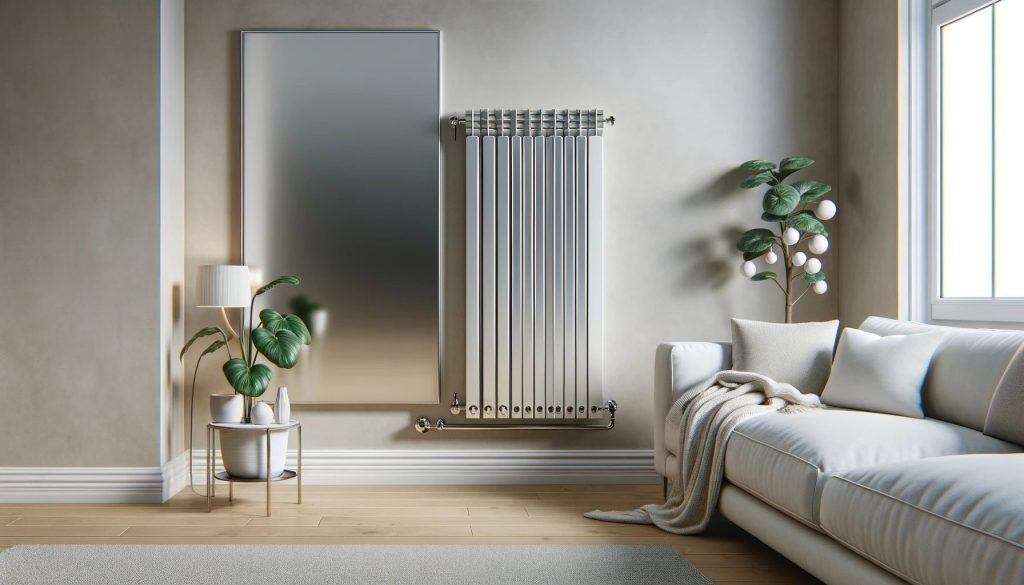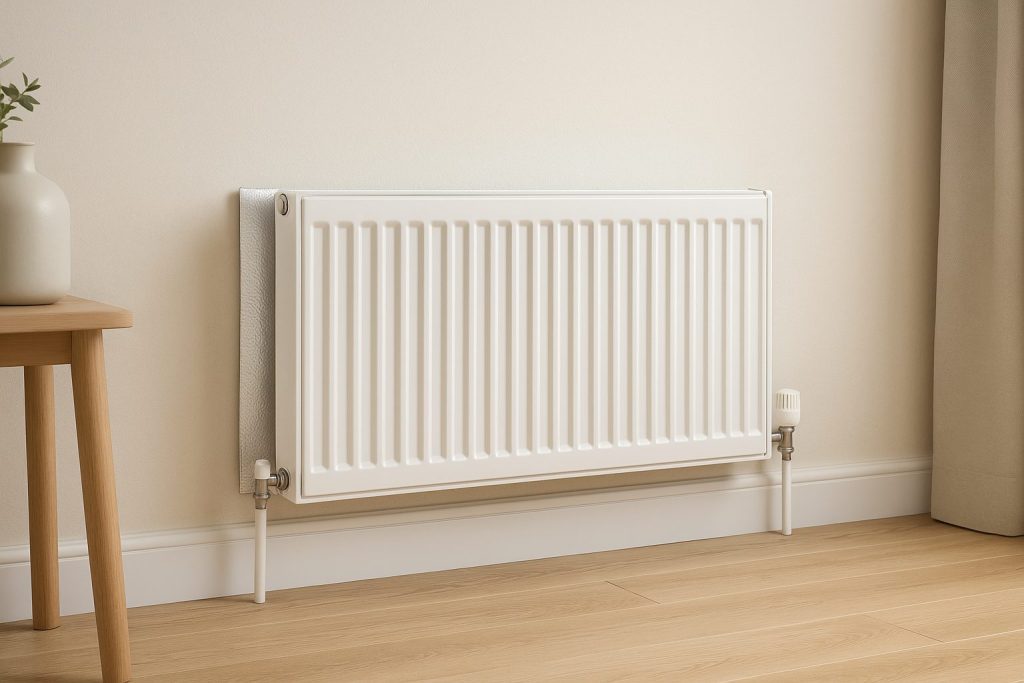Does placing foil behind your radiators save money on heating bills? What are the disadvantages? And is there a difference between kitchen foil and radiator reflectors?
As the name implies, radiators themselves are designed to radiate heat into their surroundings, e.g. into your living space.
Radiator reflectors help prevent heat loss by reflecting warmth back into the room, rather than letting it seep into the wall behind the radiator.
But, what does the research data show? In this post we explore the facts and some potential strategies you can easily adopt to get the most out of your radiators.

How Does Radiator Foil Work?
Radiator foil is designed to reflect heat from the back of a radiator back into the room, rather than letting it escape through the wall behind. It can help improve heat retention slightly—but only under the right conditions.
To be clear, we’re not talking about kitchen foil. Kitchen foil isn’t made for this job—it’s thinner, less durable, and far less reflective than dedicated radiator reflector panels. Purpose-made radiator foil (or Low-E panels) is designed to reflect radiant heat effectively, with a surface engineered to remain functional over time.
For radiator foil to make a noticeable difference, two things need to be true:
- The wall behind the radiator is uninsulated and external
- The foil is a reflective panel, not a sheet of cooking foil
Without both, its impact is minimal. And in many UK homes, especially newer builds, the walls are already insulated—making radiator foil less effective than you might think.
Should You Put Foil Behind Your Radiators?
According to official statistics released by Gov.uk, around 51% of people say that saving money on heating bills is their most important consideration. It’s also worth noting that in order for the UK government to reach its Net Zero target by 2050, the way homes are heated will need to change. These are two very good reasons to consider methods of reducing heat loss in homes. Reflective foil is one option people opt for.
Specialised reflective foil, designed to redirect warmth back into your living space, is an effective strategy to conserve heat and provide insulation.
This method is particularly beneficial for external walls, where it helps to minimise heat loss. Enhancements like shelves or fans above radiators can further help to circulate warm air back into the room. According to Ofgem, only minimal improvement in energy efficiency is possible if the radiator is fitted on a wall with a filled cavity. This confirms that radiator panels and reflectors should only be installed on external walls, solid walls or walls with unfilled cavities.
For a DIY approach, you can attach foil to cardboard panels and place them behind radiators, ensuring the reflective side faces the room.
Double-sided adhesive pads can also help to secure these panels in place.
But are there any disadvantages to installing foil behind radiators that you should be aware of?
Recommended reading:
- Should I fix my energy bills?
- How much should my energy go up?
- UK Energy Security Strategy Explained
- Where does the UK get its gas from?
- Average carbon footprint per household UK
Disadvantages of Foil Behind Radiators
Why shouldn’t you use tin foil or aluminium foil behind your radiators?
The main reason you should not use traditional kitchen foil behind your radiators is simply that it isn’t designed for this purpose.
These are the major reasons why aluminium foil is a bad idea (as opposed to purpose built radiator reflectors):
- Foil will crinkle and is unlikely to stay in the same position for long.
- Over time, foil will degrade and oxidise, diminishing its ability to reflect heat.
Using radiator foil designed for purpose is recommended if you’re opting for this route, but even when using the correct foil type, it’s not always the best choice for every home.
When Radiator Foil Doesn’t Help
Despite sounding like an easy energy win, radiator foil has its limits. In some setups, it offers little to no benefit—and in others, it may not be worth the effort at all.
Radiator foil is unlikely to help when:
- The radiator is on an internal wall
- The home is already insulated to modern standards
- The foil becomes dirty or warped over time, reducing reflectivity
In these cases, the heat isn’t escaping through the wall—so reflecting it does very little.
Radiator Foil vs. Reflective Panels vs. Kitchen Foil
Not all foils are created equal. Many DIYers turn to kitchen foil, but it’s rarely effective. Professional-grade reflective panels are specifically designed to reflect radiant heat—kitchen foil simply isn’t.
| Material | Effectiveness | Durability | Cost |
| Kitchen foil | Low | Poor | Cheap |
| DIY foil on card | Moderate | Variable | Cheap |
| Reflecting panels (Low-E) | High | Good | Moderate |
When Radiator Foil Is Most Effective
There are a few setups where radiator foil can make a difference:
- The radiator is mounted on an uninsulated external wall
- The room feels cold and there’s visible heat loss through the wall
- A professional-grade reflective panel is used, not basic kitchen foil
- The homeowner wants a low-cost, temporary solution before deeper insulation work
In these cases, adding foil can slightly improve heat retention and reduce draughts.
Radiator Foil Alternatives That Work Better
If your goal is to meaningfully reduce heating bills, radiator foil isn’t your only (or best) option. Looking into cheaper ways to heat your home will be worth your time. Here are some alternatives to radiator foil that may be beneficial:
- Thermostatic Radiator Valves (TRVs) – allow for room-by-room temperature control
- Bleeding radiators – improves heat circulation
- Loft or cavity wall insulation – significant savings over time
- Smart heating controls – better control equals less waste
- Boiler upgrades – improve energy efficiency for the whole home, but remember to consider the cost of a new boiler installation
Why Use Radiator Reflectors Instead?
The alternative to placing foil behind your radiators is a radiator reflector like those offered by the brand Radflek – easily found on Amazon.

Unlike tin foil, these will not be at the mercy of oxidisation and will maintain their shape and integrity over time.
Radiator Reflectors Real Term Savings
How much energy and money can you save by installing radiator reflectors?
Research was carried out by the BRE and shows that substantial savings can be made by installing Radflek radiator reflectors.
| Type of Property | Savings per radiator / yr (0.6sqm) | Payback (Years) |
| Insulated Cavity Walls | £0.80 | 3.7 |
| Savings per radiator/yr (0.6sqm) | £1.32 | 2.3 |
| 1976-82 Cavity Walls | £1.91 | 1.6 |
| Pre-1976 Cavity Walls | £2.75 | 1.1 |
| Uninsulated Solid Walls | £4.02 | 0.7 |
The British Board of Agrément (BBA) and verified by the BRE, also highlight that Radflek products can reduce heat transfer through walls by 45%.
Is It Worth Using Radiator Foil?
The short answer: it depends.
For older homes with uninsulated external walls, using proper radiator foil or panels could offer small gains, especially when combined with other efficiency upgrades. But for most modern UK homes, the effect is minimal.
If you’re aiming to improve heating efficiency long-term, upgrading insulation, bleeding radiators, or installing thermostatic radiator valves will usually deliver better results.
What Do The Statistics & Local Councils Say?
Reflector panels are effective in older or poorly insulated homes, especially where heat loss through external walls is significant.
Lewisham Council indicates that reflective radiator panels can reduce heat loss by up to 50% in uninsulated external-wall radiators .
Key Points
Placing foil behind radiators can reflect heat into living spaces, potentially saving on heating bills, especially effective on external walls.
However, kitchen foil isn’t ideal as it degrades and crinkles over time. Specialized radiator reflectors like Radflek are more durable and effective.
Research indicates these can significantly reduce heat transfer and provide real-term savings, with the amount saved varying by property type and wall insulation.
The British Board of Agrément confirms that Radflek can reduce heat transfer by up to 45%.
FAQs
Is Kitchen Foil as Effective as Radiator Foil?
Answer: No. Kitchen foil is thin, lacks reflective coating, and deteriorates quickly. Purpose-made radiator reflector panels are tested for thermal performance and durability, making them far more effective.
2. Will Radiator Foil Make a Difference in an Insulated Home?
Answer: In well-insulated homes, radiator foil may offer only minimal benefit. However, in older or poorly insulated properties—especially those with uninsulated external walls—purpose-made reflector panels like Radflek can help reduce heat loss by bouncing warmth back into the room instead of letting it escape into the walls.
Does Radiator Foil Work for Radiators on Internal Walls?
Answer: No. Radiators on internal walls don’t lose heat to the outside, so placing foil behind them won’t save energy or boost heat retention.
How Do I Install Radiator Reflector Panels Properly?
Answer: Clean the wall behind the radiator, then attach the panel flush to the surface using adhesive pads or tabs. Panels should be flat, secure, and positioned directly behind the heat source.
Can I Use Homemade Foil for Heating Efficiency?
Answer: DIY foil panels made from kitchen foil and cardboard may offer minimal help in uninsulated homes, but they’re far less effective and less safe than certified products like Radflek or Heatkeeper.
What’s More Effective Than Radiator Foil?
Answer: Upgrading insulation (walls, lofts), installing thermostatic radiator valves, and bleeding your radiators regularly are all more effective ways to improve heat retention and lower energy bills. You could also invest in cost-effective heaters to cut back on central heating costs.
Sources
Gov.uk – Heat and energy use in the home, Winter 2024, UK
ResearchGate – Reflecting panels for radiators in residential buildings: Theoretical analysis of energy erformance
Lewisham Council – Improving the energy efficiency of your home
ofgem – Carbon Emissions Reduction Target (CERT) Technical Guidance Manual